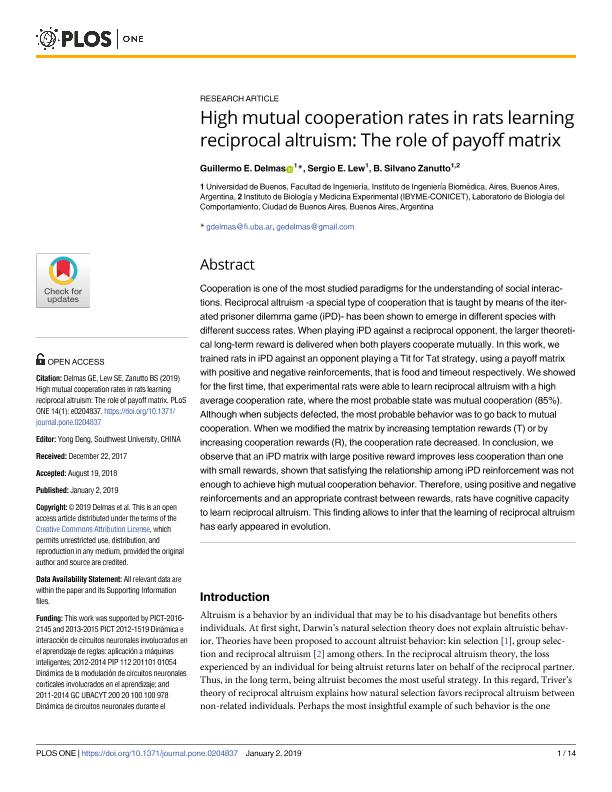Mostrar el registro sencillo del ítem
dc.contributor.author
Delmas, Guillermo Ezequiel

dc.contributor.author
Lew, Sergio Eduardo

dc.contributor.author
Zanutto, Bonifacio Silvano

dc.date.available
2020-12-15T21:45:01Z
dc.date.issued
2019-06-02
dc.identifier.citation
Delmas, Guillermo Ezequiel; Lew, Sergio Eduardo; Zanutto, Bonifacio Silvano; High mutual cooperation rates in rats learning reciprocal altruism: The role of payoff matrix; Public Library of Science; Plos One; 14; 1; 2-6-2019; 1-14
dc.identifier.issn
1932-6203
dc.identifier.uri
http://hdl.handle.net/11336/120548
dc.description.abstract
Cooperation is one of the most studied paradigms for the understanding of social interactions. Reciprocal altruism -a special type of cooperation that is taught by means of the iterated prisoner dilemma game (iPD)- has been shown to emerge in different species with different success rates. When playing iPD against a reciprocal opponent, the larger theoretical long-term reward is delivered when both players cooperate mutually. In this work, we trained rats in iPD against an opponent playing a Tit for Tat strategy, using a payoff matrix with positive and negative reinforcements, that is food and timeout respectively. We showed for the first time, that experimental rats were able to learn reciprocal altruism with a high average cooperation rate, where the most probable state was mutual cooperation (85%). Although when subjects defected, the most probable behavior was to go back to mutual cooperation. When we modified the matrix by increasing temptation rewards (T) or by increasing cooperation rewards (R), the cooperation rate decreased. In conclusion, we observe that an iPD matrix with large positive reward improves less cooperation than one with small rewards, shown that satisfying the relationship among iPD reinforcement was not enough to achieve high mutual cooperation behavior. Therefore, using positive and negative reinforcements and an appropriate contrast between rewards, rats have cognitive capacity to learn reciprocal altruism. This finding allows to infer that the learning of reciprocal altruism has early appeared in evolution.
dc.format
application/pdf
dc.language.iso
eng
dc.publisher
Public Library of Science

dc.rights
info:eu-repo/semantics/openAccess
dc.rights.uri
https://creativecommons.org/licenses/by-nc-sa/2.5/ar/
dc.subject
paradigms
dc.subject
prisoner dilemma
dc.subject
cooperation rate
dc.subject.classification
Otras Ingeniería Eléctrica, Ingeniería Electrónica e Ingeniería de la Información

dc.subject.classification
Ingeniería Eléctrica, Ingeniería Electrónica e Ingeniería de la Información

dc.subject.classification
INGENIERÍAS Y TECNOLOGÍAS

dc.title
High mutual cooperation rates in rats learning reciprocal altruism: The role of payoff matrix
dc.type
info:eu-repo/semantics/article
dc.type
info:ar-repo/semantics/artículo
dc.type
info:eu-repo/semantics/publishedVersion
dc.date.updated
2020-11-17T18:30:59Z
dc.journal.volume
14
dc.journal.number
1
dc.journal.pagination
1-14
dc.journal.pais
Estados Unidos

dc.journal.ciudad
San Francisco
dc.description.fil
Fil: Delmas, Guillermo Ezequiel. Universidad de Buenos Aires. Facultad de Ingeniería; Argentina. Consejo Nacional de Investigaciones Científicas y Técnicas; Argentina
dc.description.fil
Fil: Lew, Sergio Eduardo. Universidad de Buenos Aires. Facultad de Ingeniería; Argentina. Consejo Nacional de Investigaciones Científicas y Técnicas; Argentina
dc.description.fil
Fil: Zanutto, Bonifacio Silvano. Universidad de Buenos Aires. Facultad de Ingeniería; Argentina. Consejo Nacional de Investigaciones Científicas y Técnicas. Instituto de Biología y Medicina Experimental. Fundación de Instituto de Biología y Medicina Experimental. Instituto de Biología y Medicina Experimental; Argentina
dc.journal.title
Plos One

dc.relation.alternativeid
info:eu-repo/semantics/altIdentifier/url/https://journals.plos.org/plosone/article?id=10.1371/journal.pone.0204837
dc.relation.alternativeid
info:eu-repo/semantics/altIdentifier/doi/http://dx.doi.org/10.1371/journal.pone.0204837
Archivos asociados
